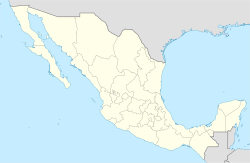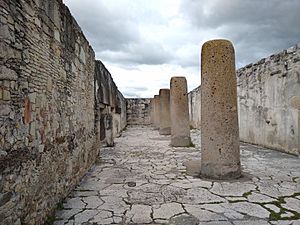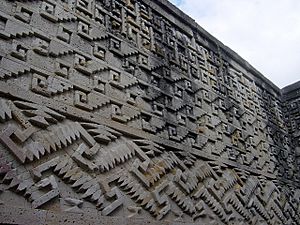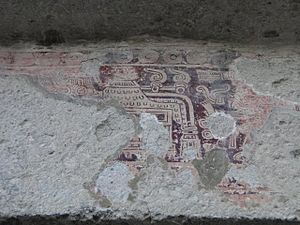Mitla facts for kids
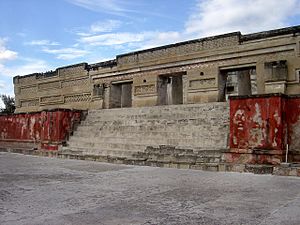
Palace at Mitla
|
|
| Location | Oaxaca, Mexico |
|---|---|
| Region | Oaxaca Valley |
| Coordinates | 16°55′38″N 96°21′34″W / 16.92722°N 96.35944°W |
| Official name | Prehistoric Caves of Yagul and Mitla in the Central Valley of Oaxaca |
| Type | Cultural |
| Criteria | iii |
| Designated | 2010 (34th session) |
| Reference no. | 1352 |
| Region | Latin America and the Caribbean |
Mitla is an amazing ancient site in Oaxaca, Mexico. It's the second most important archaeological site in the state. It was once the main religious center for the Zapotec culture.
Mitla is about 44 kilometers (27 miles) from the city of Oaxaca. It sits high up in the Tlacolula Valley, surrounded by mountains. The site is part of the modern town of San Pablo Villa de Mitla. While Monte Albán was a major political center, Mitla became very important for religious ceremonies. This happened later, when the Mixtec people also lived in the area.
The name Mitla comes from the Nahuatl word Mictlán. This means "place of the dead" or "underworld." The Zapotec people called it Lyobaa, meaning "place of rest." The Spanish later changed Mictlán to Mitla. It was a sacred burial site for the Zapotec. Its buildings and designs also show the influence of the Mixtec culture.
Mitla is special because of its detailed mosaic designs. These patterns cover tombs, walls, and even entire buildings. They are made from small, perfectly cut and polished stones. These stones fit together without any mortar, like a giant puzzle! No other ancient site in Mexico has this kind of decoration.
Contents
Exploring Mitla's Past
The Oaxaca Valley has many well-preserved ancient sites. Its cool, dry weather helps keep them safe. The Zapotec people settled this valley over a thousand years ago. They built a complex society with leaders and rules. Even though the valley was a bit isolated, the Zapotec traded ideas with other groups. This is clear from their pottery and other cultural items.
By the 1500s, the Mixtec people had also moved into the area. The Zapotec state had over 500,000 people. They used advanced building methods and had their own writing system. They also used two calendar systems. Their main crops were maize (corn), beans, squash, and chili peppers. They grew these using clever irrigation systems and terraces on mountain slopes. This helped feed the many people living in the cities.
Mitla was first lived in around 100 to 650 CE, or maybe even earlier. It started as a small, protected village. Later, it grew into the Zapotec's main religious center. The Mixtec took control around 1000 CE, but many Zapotec still lived there. The city was at its biggest and best between 750 and 1521 CE. You can see both Zapotec and Mixtec styles in its buildings from that time.
Ancient people in Mesoamerica believed death was a very important part of life. Mitla was built as a special gateway. It was thought to connect the world of the living with the world of the dead. Nobles buried at Mitla were believed to become "cloud people." These cloud people would then help the living.
Mitla was still a busy religious center when the Spanish arrived in the 1520s. The main priest, called the Uija-tào, lived there. The Spanish thought he was like their pope. At that time, the city covered a large area. Farmers grew food in the surrounding countryside to feed everyone.
Early Spanish soldiers and missionaries wrote about Mitla. Friar Toribio de Benavente Motolina described it in the mid-1500s. He said its name meant "hell," seeing it as a place of the underworld.
In 1553, the Archbishop of Oaxaca ordered Mitla to be destroyed. He wanted to break its power over the local people. Spanish forces attacked the buildings, taking them apart. Many stones were used to build Spanish churches. The Church of San Pablo was built right on top of some of the ruins. Even the Cathedral of Oaxaca uses designs from Mitla. This showed that the new religion was taking over the old culture.
Today, Mitla is the second most important archaeological site in Oaxaca. In the early 1900s, the Mexican government chose Mitla as a symbol of ancient Mexico. This was for Mexico's Independence celebrations. Famous archaeologist Alfonso Caso worked at Mitla in the 1920s and 1930s.
Since the 1980s, more excavations have happened at Mitla. The colonial church area was explored in the early 2000s. Mexico is working hard to protect these ancient ruins.
What Mitla Looks Like
Mitla is different from sites like Monte Albán. Instead of pyramids on a ridge, Mitla's buildings are on the valley floor. The valley is high up in the mountains, over 1,400 meters (4,500 feet) high. Mitla's buildings were designed for comfort, not just for showing off. Building the ceremonial center of Mitla began around 850 CE. The city was still growing when the Spanish arrived and destroyed it.
The oldest buildings at Mitla date back to 450 to 700 CE. They look similar to buildings at Monte Albán. Mitla is one of the few sites that grew important when the Mixtec became powerful. Its architecture shows a mix of Mixtec and Zapotec styles. This mix was at its best around 1200 CE. Later, Catholic churches also used Zapotec designs. They built churches like San Pedro and Calvario Chapel over old temple foundations.
The stone walls at Mitla were built in a special way. They have a core of mud and stone. This core was covered with plaster or carefully cut trachyte rock. Some huge stones, like those used for columns, weigh up to 18 tons! Moving and placing these stones needed many workers.
Today, Mitla has five main groups of buildings. A fence of cactus plants surrounds much of the site. The groups are called the South, Adobe, Arroyo, Columns (or Palace), and Church (or North) Group. All the buildings face the main compass directions. The South and Adobe Groups were ceremonial centers. They have central plazas with mound structures. The South, Columns, and Church groups were palaces. They have rooms around square courtyards. The two best-preserved groups are the Columns Group and the Church Group. They are both at the north end of the site.
The Columns Group and the Church Group were fully dug up and fixed by the early 1980s. They are now open for visitors. Both have rectangular courtyards. These courtyards are surrounded by one-story rectangular buildings with long, narrow rooms.
Church Group
You enter the site through the Church or North Group. In the 1500s, the Spanish built the Church of San Pablo here. It sits on a large ancient platform, which is now the church's courtyard. The Zapotec believed the lord and lady of the underworld lived in these buildings. The Spanish built their church here to show their power.
This group also has the main Zapotec temple, called the yohopàe. This means "house of the vital force." The temple faces a large courtyard. Its entrance has two big columns. These lead into a front room that once had a roof. Beyond this room is the main chamber. Here, priests burned incense and performed ceremonies. Behind this main room were the priests' living areas. The walls in this building are covered with detailed mosaic patterns. There are also paintings showing myths and characters.
Under some buildings, there are stone tombs shaped like a cross. You reach them by stairs from the patio. Inside, they are decorated with mosaics. One tomb has an entrance split by a thick column. This column is known as the "Columna de la Vida" (Column of Life). Legend says if you hug the column, the space between your hands shows how much life you have left.
Columns Group
South of the Church Group is the Columns Group. Its main building is called the Palace. This group has two entrances facing south. The entrance room has huge columns that once held up the roof. A small opening on the north wall faces the patio. People believe this opening was a way to the afterlife.
The main building is called the Palace or the Grand Hall of Columns. It is about 36 meters (120 feet) long and 6.4 meters (21 feet) wide. It has six columns of volcanic stone that supported the roof. After a small hallway, you reach the courtyard. This courtyard is beautifully decorated with mosaic patterns. The north and east buildings of this group have elaborate tombs. High priests and Zapotec rulers were buried here. In front of the north building's stairs is a cross-shaped tomb. Its ceiling has large stone beams. The walls are decorated with stone tablets and patterns. The east building has a single large stone column that supports its roof.
Amazing Stone Friezes
The most unique thing about Mitla is its detailed mosaic patterns. These geometric designs are called grecas in Spanish. They cover the walls of both the Church and Columns groups. Thousands of cut, polished stones are fitted together without mortar. The stones were placed against a red stucco background. They stay in place because of the weight of the surrounding stones. Walls, decorative bands (friezes), and tombs are all covered with these patterns. Sometimes, these stone "tiles" are even set directly into stone beams. These elaborate mosaics are like a "Baroque" style. They are very fancy and detailed, sometimes covering entire walls. No two patterns are exactly the same anywhere in Mitla. This kind of stone artwork is found nowhere else in Mesoamerica.
Protecting Mitla's History
Two main problems for Mitla are erosion from wind and rain, and graffiti. Graffiti, often painted or carved by visitors, has been a big problem for a long time. To protect the ruins, especially the grecas, shelters have been built over some rooms. These shelters have palm-thatched roofs supported by wood. They look like the roofs used in ancient times.
Projects are underway to rebuild parts of the site. This includes fixing a 17th-century wall in the Church Group. They are also laying stucco floors in the Columns Group. Other work involves sealing platforms and walls, and restoring an old rainwater collection tank. This tank was the only one of its kind built in the valley during colonial times.
Mitla is part of a plan called the Archeology Corridor of Oaxaca Valley. The government wants to keep and restore the ruins. They also want to make the site easier for visitors to explore. Archaeologists like Nelly Robles also want Mitla to be recognized as a World Heritage Site by UNESCO. It is already on Mexico's list of national heritage sites. Mitla is listed with the Tree of Tule and nearby caves. These caves have ancient paintings and show human life from 8,000 years ago.
Visiting Mitla
Mitla is the second most visited archaeological site in Oaxaca, after Monte Albán. Tourism is very important to the modern town of San Pablo Villa de Mitla. It helps most of the local economy. Many people feel the government should do more to promote the site and the town. However, officials say that more and more tourists are visiting. Most visitors are Mexicans from Veracruz and Puebla states. Many foreign visitors come from Europe. On average, about 500 people visit Mitla every day.
See also
 In Spanish: Mitla para niños
In Spanish: Mitla para niños


